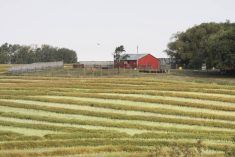Although Canada’s new dominion government began making provisions for rural country schools in the Northwest Territories in the early 1870s, it would be another 15 years or so before a formal, organized school system would take root in the area that would soon become the province of Saskatchewan.
In 1871, the Dominion Land Survey allowed for sections 11 and 29 in each surveyed township to be used as school sections, according to the Saskatchewan One Room School Project, an online resource at sites.rootsweb.com/~cansk/school/.
By 1886, what was then the Northwest Territories, which included present-day Saskatchewan, held its first board of education meeting, an event attended by Edgar Dewdney, who served as lieutenant governor of the territories from 1879 to 1888.
Read Also

Nutritious pork packed with vitamins, essential minerals
Recipes for pork
The 1886 board meeting marked the birth of a formal and “civilized” education system in the northwest, according to historical documents. It also paved the way for the emergence of one-room schoolhouses across the Canadian Prairies.
Not long after the meeting, new school districts began to spring up, including the Qu’Appelle School District No. 2, the Prince Albert School District No. 3, the Regina School District No. 4, the Broadview School District No. 5, the Kenlis School District No. 6, near Abernethy, Sask., and the Maverick School District No. 7 in Moose Jaw.
At the time, it was assumed by many that the Canadian northwest, including present-day Saskatchewan, would develop slowly and that a tax-funded education system should therefore not be imposed.
But by the turn of the century, there were nearly 500 school districts registered and the number of one-room schoolhouses was growing quickly, in step with the rapid settlement of the West under the immigration policies of interior minister Clifford Sifton.
“From 1900 to 1920, schools could not be supplied fast enough,” according to the Saskatchewan One Room School Project.
“From 1900-1920, schools were organized at a rate of one a day, giving rise to the Saskatchewan Pioneer Slogan: A New School Everyday for Twenty Years.”
At the time, nearly 85 percent of all residents in Saskatchewan were rural, involved in agriculture or in businesses that supported rural residents.
By the early 1920s, the construction of one-room schoolhouses was standardized, and by the early 1930s, there were more than 5,000 school districts in the province, including 4,870 that were operational.
However, by the late-1930s, many schoolhouses were no longer in use and some had fallen into a state of disrepair due to lack of funds and outward migration that occurred during the 1930s.
By the late 1940s, the number of one-room schoolhouses had peaked in the province and by the mid-1950s, school bus routes allowed rural students to be bussed longer distances to larger schools in newly formed provincial school units.
By 1960, despite a provincial population of nearly 850,000 people, eight out of every 10 rural schools in Saskatchewan had closed their doors, including the Lake City School District, No. 1431.

















